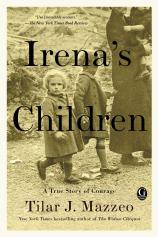Author Talk: September 30, 2016
Tilar J. Mazzeo is the New York Times bestselling author of multiple nonfiction books that tell stories of strong, resourceful women in impossible situations. In this interview, Mazzeo opens up about the joys and obstacles of historical storytelling, including --- as is the case with her latest book, IRENA’S CHILDREN, about a real-life social worker who risked her life to save 2,500 children from the Holocaust --- becoming emotionally attached to her subjects. She also discusses why the telling of history, be it personal or national, can never be subjective.
Question: What first inspired you to tell the story of Irena Sendler? Can you discuss the book’s origins? Why were you particularly interested in telling the story from Irena’s point of view?
Tilar J. Mazzeo: In the first pages of the book, I talk a bit about how I came to write Irena’s story and about how I first heard about this “lost” heroine in Poland. For me, Irena is at the center of a group of friends who do something amazingly courageous and decent, and I tell the story from her perspective because, in a sense, she’s the ringleader. But, in a way, I also think of this as a book about the perspectives of a small group of friends --- Irena, Ala, Rachela --- and how their stories unfold in different directions.
Q: Where and how did you begin to write the story of Irena Sendler, and how did you choose where to end the story?
TJM: I chose to begin the book with one of the most dramatic scenes in Irena’s life: the moment that she is arrested by the Gestapo. I thought that it was important for the reader to understand, from the very beginning, the stakes. The actions that Irena and her friends took were truly a life-or-death gamble. But it was also important, after that, for the book to move chronologically through Irena’s childhood, because the influence of her father was profound.
This biography of Irena stops at the end of the Second World War, and there were complex reasons for this. The primary reasons are that telling the story of the Communist period in Poland and gathering the archival materials that would be required is still extremely challenging. Poland is going through an informal period of “truth and reconciliation,” and for many people this is still a period of living memory. These are stories that need more time to pass before they can be told with the kind of complexity the history demands. But there were also other reasons. After the war, Irena was in a particularly difficult situation, and it was a large part of the reason why her wartime story was silenced for such a long period. For her, what came after the war was another life entirely. So I think of this book as “the first life” of Irena Sendler.
Q: In the Afterword, you clearly categorize this book as a work of nonfiction. Why did you choose to write and present the book in this way?
TJM: Irena Sendler is a historical public figure, and she and her friends did the things I write about in this book. The children she saved were real people, who went on to have real lives and families, in most cases. So nonfiction was an easy decision. But nonfiction doesn’t mean that this is the one and only truth about these people or this moment in history. Nonfiction is a window on the past from one perspective. Historical storytelling always involves an element of subjectivity, and it always tells you something about the personality and interests of the storyteller as well as her subjects.
Q: What kinds of sources did you consult in order to prepare for the writing of this book?
TJM: This was a very intensively researched book. I consulted with historical materials in archives around the world, especially in the United States, Canada, Germany, Poland and Israel. I also had the opportunity to speak with a number of people who knew Irena or other people in the story such as Ala and Adam. Some of those people included a number of “Irena’s children.”
Q: What information that you discovered was the most surprising to you?
TJM: I find the story of Ala incredibly moving and inspiring, and that was a story that I discovered only halfway through the writing of this book. There were moments when I wished that I was also writing the biography of Ala, and I did revise the book late in the process to tell more of her story alongside Irena’s. The story of those two friends --- who were both so brave and dedicated --- and how their lives unfolded is very poignant to me and says something important, I think, about the truth of the Second World War.
Q: What were the biggest obstacles you faced in writing this book, and how did you overcome them?
TJM: While the research for this book often involved quite a lot of problem solving and creativity to find the pieces of the story, the hardest part of writing this book was emotional. It is very difficult to sit down every day and read or write about this kind of mortal danger and the history of the Nazi period, especially because when you write biography you become quite attached to your subject in intimate ways. I spent more time “with” Irena than with anyone else in my life during the time I was writing this book. You also become very emotionally involved during personal interviews in some cases, especially when you are talking about Holocaust experiences and the life or death of people’s families.
The last summer I worked on this book was especially challenging: Outside my study, I could hear the joyful screams of my young stepchildren and my young niece and nephew --- the niece and nephew I write about in the first pages of the book --- jumping in the pool and running around. Inside, I was reading about Treblinka and the fate of other small children. They were very complicated feelings, but I think having them made the book better and more compassionate.
Q: How did the research and writing of this book change or influence your own view or interpretation of the events featured in the book?
TJM: Although this biography doesn’t narrate the story of Irena’s “second life” after the Second World War, the process of writing this book and deciding not to write about the Soviet period in Irena’s life changed my understanding of the Cold War and Eastern Europe’s position profoundly. As someone who grew up during the Cold War, I was surprised in researching this book how much I didn’t know about that period and by how abiding its legacy is.
Q: IRENA’S CHILDREN seems like a departure from your previous works, but your books also share some overlapping themes. Can you discuss these? What do you think that your works have in common? What binds them as an oeuvre?
TJM: I suppose this book is a departure in the sense that the subject is a somewhat darker one. My earliest books were on the history of champagne and businesswomen, and I do still have a strong interest in both wine and in the history of entrepreneurship. But in another sense, IRENA’S CHILDREN is very much part of my long-standing interest in biography. I’ve mostly written the biographies of strong, independent women, though without setting particularly out to do so. But I think what ties my books together most powerfully in my own experience of them is that I am interested in the stories of what people do when they are placed in difficult or even impossible situations.
What do you do if you are a Jewish American woman living under a false passport in Paris and married to the director of the Hotel Ritz during the German occupation? Do you go home? Do you fight? Do you hide? Do you go mad? That is the story of Blanche Auzello in THE HOTEL ON PLACE VENDÔME. Or what do you do if you’re a twentysomething young widow, with no business experience and born at a time when women aren’t supported in working, and what you really want to do is build a company? What do you do when, given a chance to try, your first efforts are a failure? That’s the story of THE WIDOW CLICQUOT. And here, the questions Irena Sendler and her friends faced were another version of that dilemma.
Q: How has IRENA’S CHILDREN influenced your current writing projects or changed the way you write?
TJM: Writing this book has reminded me how rich the experience of writing biography, as a particular subset of narrative nonfiction, can be, and I think I will probably do more in that genre as a result of IRENA’S CHILDREN. At the same time, I think I will probably take a break from writing about the Holocaust for a while. I’ve written two books in a row now on the Second World War, and I know more about the Gestapo than any person ought to.
Q: As a reader, who are some of the storytellers you find most inspiring, and why?
TJM: I suppose I tend to enjoy reading the same kinds of narrative nonfiction that I want to write, and I’ve often learned a great deal from other writers. Joan Didion’s essay “Goodbye to All That” is one of the most beautiful pieces of short memoir I know. Recently I also read John Vaillant’s THE GOLDEN SPRUCE, a nonfiction story about a tree sacred to the native people of British Columbia and the ecological disaster of the West, and I thought it was brilliantly done. I am also a great fan of Leonard Cohen’s novel BEAUTIFUL LOSERS, which I think captures something important about how history and storytelling are caught up with each other. I am interested in books that reimagine narrative nonfiction as a genre in which the storyteller is also a silent character.
Q: Are there any significant events from your own childhood or adolescence that you feel ultimately shaped the course of your life and your identity? And how has your own interpretation of this event changed over the years?
TJM: Well, this is a very complicated question, and some day, perhaps, I will write a memoir about the answer to it. For the moment, what I can say is that you don’t end up with a name like mine unless there is a good story behind it. My experience of my personal history is that storytelling is at the heart of all our identities.




